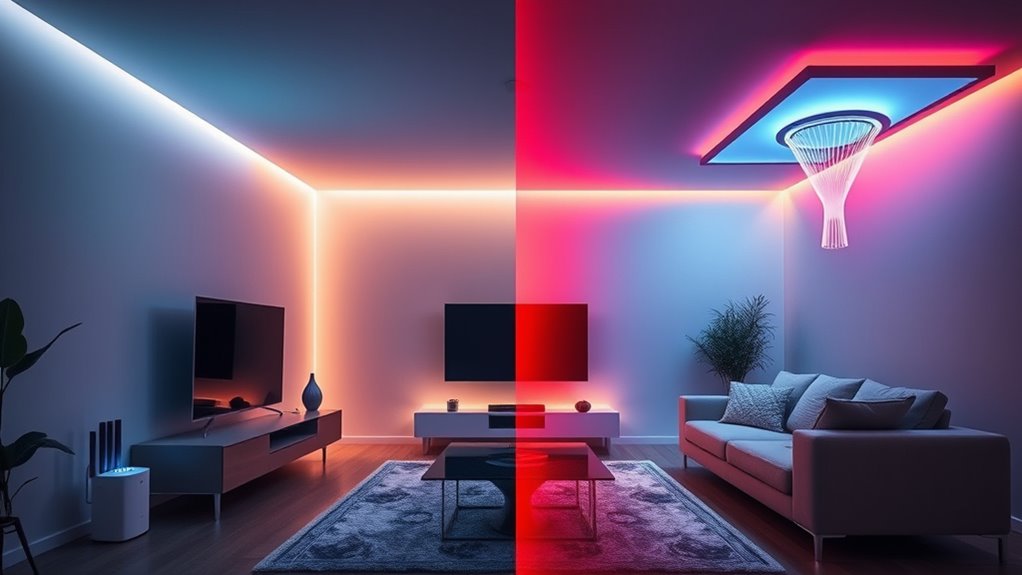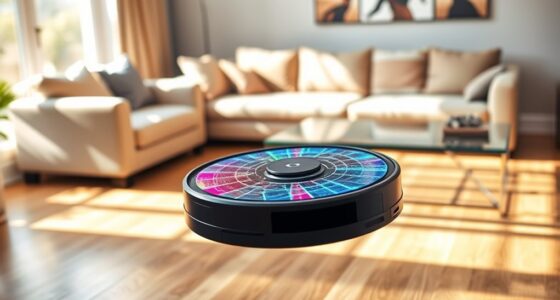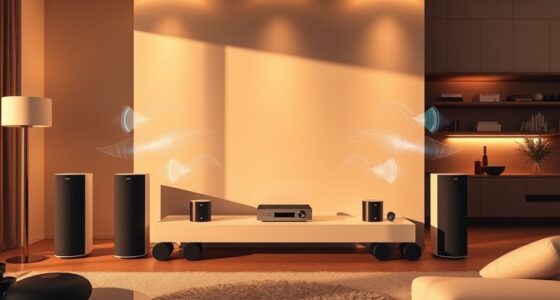Wi-Fi is the dominant home internet technology due to its reliability and affordability, but Li-Fi offers ultra-fast speeds and enhanced security by using visible light for data transfer. While Li-Fi’s high performance and resistance to interference sound promising, it requires specialized lighting and can be affected by obstructions. If you’re curious about which option might suit your home best and how these innovations could impact your connectivity, keep exploring the differences and future prospects.
Key Takeaways
- Wi-Fi offers widespread compatibility and lower initial costs, while Li-Fi provides faster speeds and enhanced security.
- Li-Fi transmits data through visible light, making it more secure but sensitive to obstructions; Wi-Fi uses radio waves, more flexible but prone to interference.
- Future home internet may combine both technologies for optimal speed, security, and reliability.
- Li-Fi’s higher speeds and interference-free operation position it as a promising next-generation solution.
- Cost and infrastructure requirements currently favor Wi-Fi, but Li-Fi’s advantages could drive wider adoption over time.
Understanding the Basics of Wi-Fi and Li-Fi
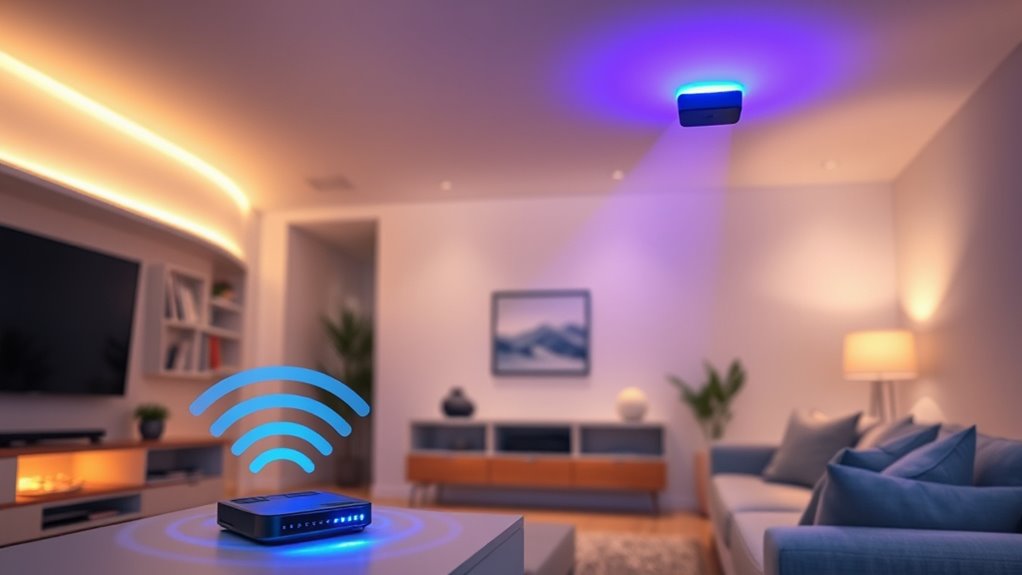
Wi-Fi and Li-Fi are two technologies that enable wireless communication, but they operate in different ways. Wi-Fi uses radio waves to transmit data, relying on specific network protocols like IEEE 802.11 to establish wireless connectivity. It’s widely used in homes, offices, and public spaces, offering broad coverage and compatibility with various devices. Li-Fi, on the other hand, transmits data through visible light, utilizing LED lights to create a high-speed wireless connection. It leverages different protocols suited for light-based communication, which can provide faster data transfer rates in certain environments. While Wi-Fi is versatile and well-established, Li-Fi’s potential lies in its ability to deliver secure, interference-free connectivity, especially in settings where radio waves might be limited or problematic. Additionally, creating a reliable connection can be more challenging with Li-Fi in areas with inconsistent lighting conditions.
How Wi-Fi Works in Home Environments
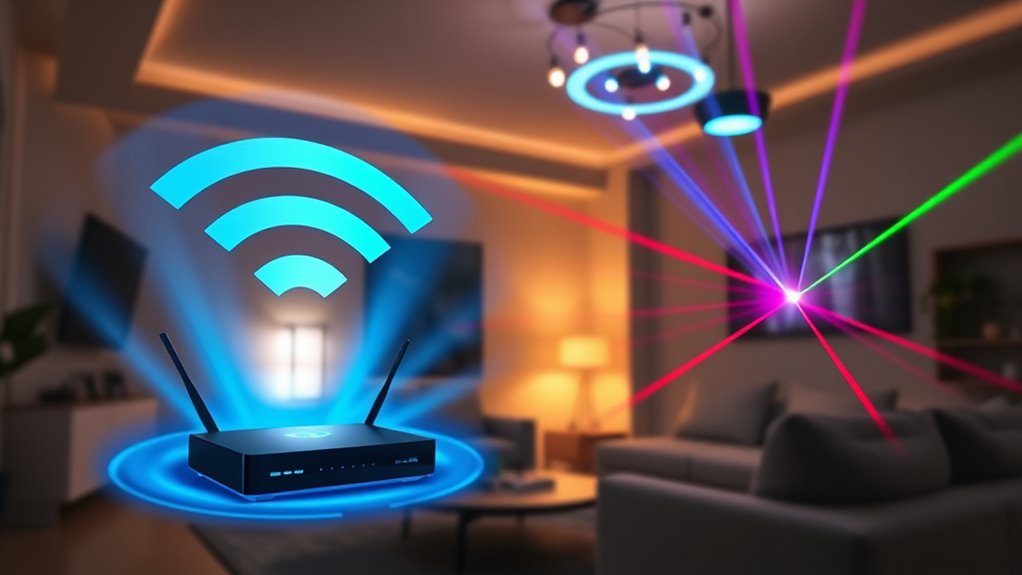
In a typical home setup, a wireless router acts as the central hub, sending and receiving data signals to connect your devices to the internet. Wi-Fi works by transmitting radio waves over specific frequency bands, primarily 2.4 GHz and 5 GHz. As more devices connect, network congestion can occur, slowing down your connection. To optimize performance, your router manages data traffic and reduces interference. Keep in mind that Wi-Fi also consumes power, especially with multiple devices active. Here’s how Wi-Fi functions in your home:
- Devices communicate with the router through radio signals.
- The router directs data to the appropriate device.
- Network congestion can cause slower speeds.
- Power consumption increases with device activity and signal strength.
- The presence of multiple connected devices can lead to network congestion, impacting overall performance.
The Technology Behind Li-Fi
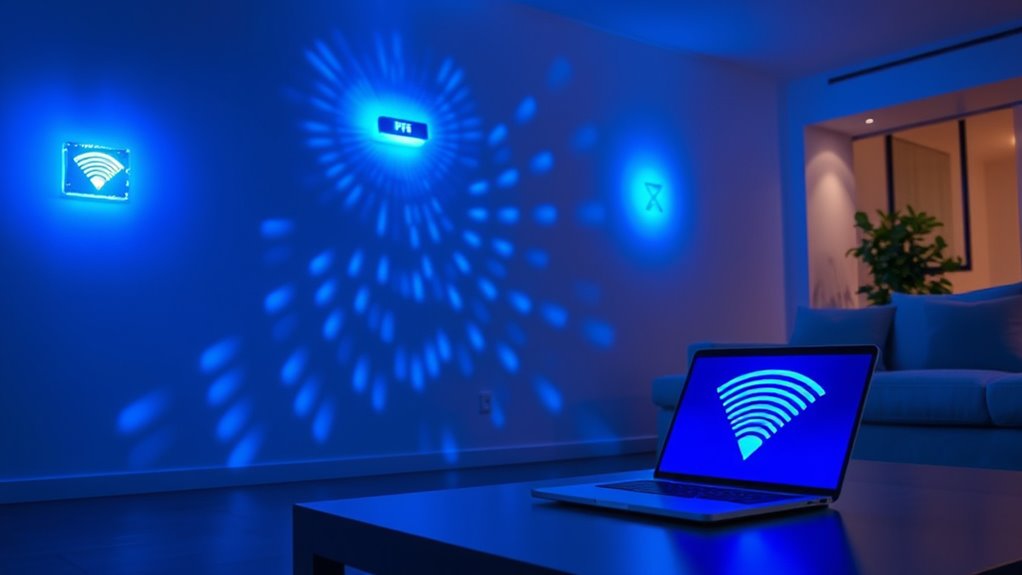
Li-Fi uses light to transmit data, making it different from Wi-Fi‘s radio signals. It leverages the visible spectrum, which allows for faster speeds and less interference. Additionally, Li-Fi offers enhanced security because light signals don’t pass through walls, reducing unauthorized access. Implementing juice cleanse techniques can also improve overall health, which is beneficial for individuals adopting new technologies that promote wellness.
Light-Based Data Transmission
Light-based data transmission relies on modulating the intensity of visible light emitted by LEDs to send information. This process involves changing the light frequency rapidly, which your eyes can’t detect, to encode data. The LED flickers at high speeds, allowing data to be transmitted seamlessly. Balancing poses cultivate concentration and breath awareness, enhancing the overall effectiveness of the technology. Here’s how it works:
- Light frequency is adjusted to encode bits of data.
- Data encoding translates digital information into light signals.
- The LED’s flickering is imperceptible to humans but detectable by photodiodes.
- This method enables high-speed, secure communication within a room.
Visible Spectrum Utilization
Visible spectrum utilization forms the core of Li-Fi technology by harnessing the vast array of frequencies within visible light. Unlike Wi-Fi, which uses radio waves, Li-Fi transmits data through the light spectrum, specifically visible light emitted by LEDs. When you turn on a Li-Fi-enabled light, it flickers at extremely high speeds, imperceptible to the human eye. These rapid changes encode data, allowing your devices to receive information from the light source. The visible light used in Li-Fi offers a much wider spectrum than radio frequencies, enabling faster data transfer. This utilization of visible light not only increases bandwidth but also reduces interference, making Li-Fi a promising alternative for high-speed, secure, and efficient internet connections within your home. Additionally, understanding foraging ranges highlights how extensive the potential for light-based communication can be in various environments.
Speed and Security Benefits
Because it uses the visible light spectrum, Li-Fi can achieve substantially higher data transfer speeds than traditional Wi-Fi, often reaching multiple gigabits per second. This rapid speed diminishes network congestion, ensuring smoother streaming and file transfers. Additionally, Li-Fi offers enhanced security since light signals don’t pass through walls, making eavesdropping difficult. The technology also supports robust data encryption, safeguarding your information from cyber threats. Furthermore, passive voice detection tools can help writers create clearer, more direct sentences. Here are some key benefits:
- Faster data transfer speeds improve overall performance.
- Reduced network congestion ensures consistent connectivity.
- Light-based signals limit data breaches to physical proximity.
- Stronger data encryption enhances security and privacy.
These features make Li-Fi not only faster but also safer than traditional Wi-Fi for your home internet needs.
Comparing Speed and Bandwidth Capabilities
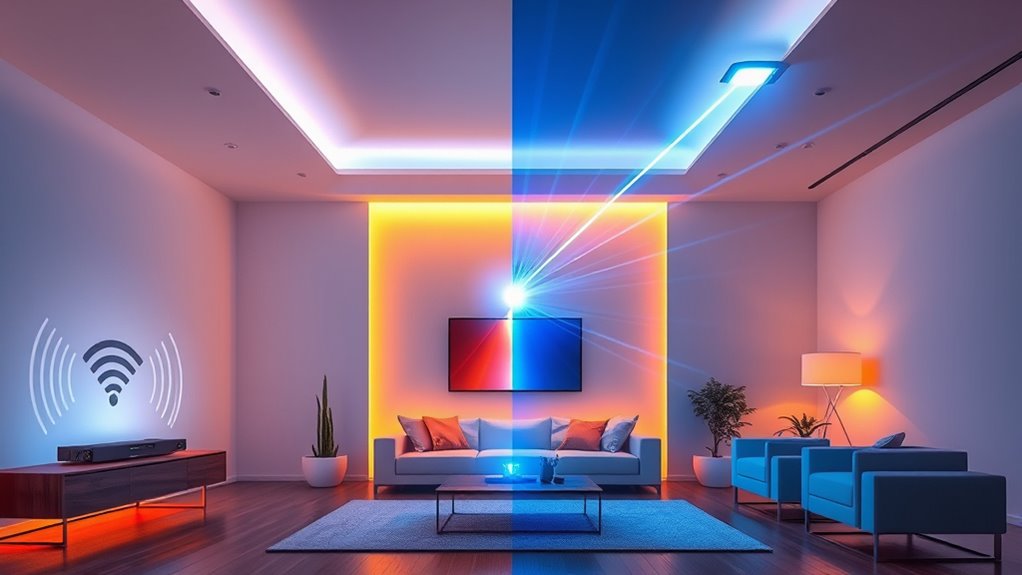
While Wi-Fi has long been the standard for wireless internet, Li-Fi offers impressive speed and bandwidth potential that often surpasses traditional Wi-Fi. Unlike Wi-Fi, which relies on radio frequencies, Li-Fi uses visible light from LED bulbs to transmit data, leveraging fiber optics technology for faster, more reliable signals. This allows Li-Fi to achieve speeds up to several gigabits per second, far exceeding typical Wi-Fi connections. Bandwidth capacity is also higher with Li-Fi, making it ideal for data-intensive tasks like streaming or large file transfers. Since wireless signals in Li-Fi are confined to a room and don’t penetrate walls, interference is minimized, ensuring consistent, high-speed connections. Additionally, light-based data transmission can enhance security by preventing data interception from outside the room. Overall, Li-Fi’s speed and bandwidth capabilities make it a promising alternative for future home internet needs.
Security Aspects of Wi-Fi and Li-Fi
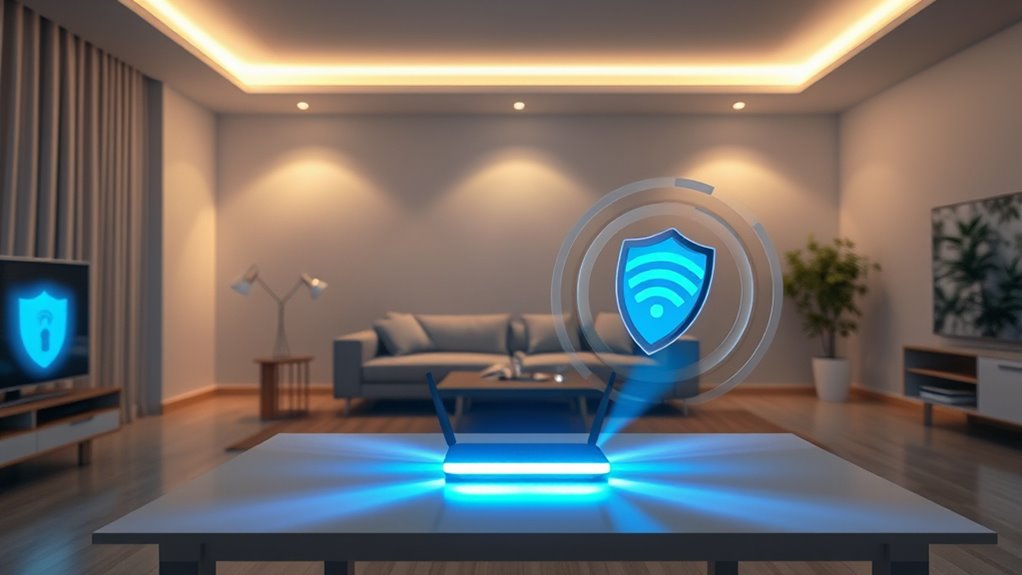
Security is a crucial factor to consider when choosing between Wi-Fi and Li-Fi. Wi-Fi networks often face risks to network privacy due to their radio signals that can be intercepted, making data encryption essential. Li-Fi offers a different security approach since it uses visible light, which doesn’t penetrate walls, reducing outside access. Here are some key points:
- Wi-Fi’s vulnerability to hacking highlights the importance of strong data encryption.
- Li-Fi’s confinement to a physical space enhances network privacy.
- Wi-Fi requires robust security protocols like WPA3 for protection.
- Li-Fi’s limited range minimizes the risk of unauthorized access.
- Incorporating diverse designs and materials can further enhance the physical security of indoor lighting-based data transmission setups.
Understanding these security aspects helps you make an informed choice based on your need for privacy and data safety.
Installation and Accessibility Challenges
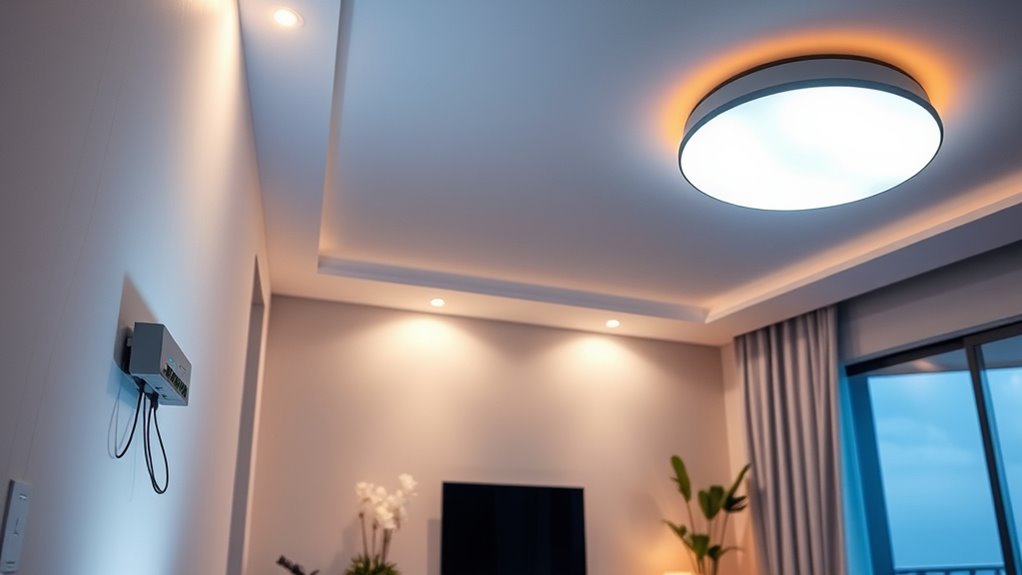
Installing Li-Fi requires specialized infrastructure that can be expensive and complex to set up, unlike Wi-Fi’s more flexible approach. Signal interference and physical obstructions can disrupt both technologies, but Li-Fi is especially sensitive to line-of-sight issues. Additionally, device compatibility may limit your options, as not all gadgets support Li-Fi technology right now. Since Halloween decorations often include creative lighting ideas, it’s important to consider how these might interfere with Li-Fi signals if used indoors.
Infrastructure Requirements and Costs
Implementing Wi-Fi and Li-Fi networks involves distinct infrastructure requirements that influence both installation costs and accessibility. For Wi-Fi, minimal infrastructure upgrades are needed—just routers and access points—keeping installation costs relatively low. In contrast, Li-Fi demands a more extensive setup, including installing LED lighting with embedded data transmission capabilities and possibly upgrading existing electrical wiring. Here are some key points to consider:
- Initial investment in Li-Fi hardware can be higher due to specialized equipment.
- Infrastructure upgrades may be necessary to support ideal Li-Fi performance.
- Wi-Fi installation costs are generally lower, requiring fewer components.
- Accessibility can be affected by the need for visible light coverage in Li-Fi, limiting placement options.
Understanding these factors helps you gauge the financial and logistical implications of adopting either technology.
Signal Interference and Obstructions
While the infrastructure setup for Wi-Fi and Li-Fi differs considerably, both face unique challenges related to signal interference and physical obstructions. Wi-Fi signals can experience disruption from walls, furniture, and electronic devices, causing slower speeds or dropped connections. Li-Fi, on the other hand, relies on light, making it vulnerable to obstructions like curtains or furniture that block the light path, leading to signal disruption. Additionally, device compatibility becomes a concern: Wi-Fi works with most devices, while Li-Fi requires specialized hardware. Here’s a comparison:
| Aspect | Wi-Fi | Li-Fi |
|---|---|---|
| Signal Disruption | Walls, electronics, interference | Obstructions blocking light |
| Physical Obstructions | Furniture, walls | Curtains, objects blocking light |
| Device Compatibility | Most devices | Limited, requires special hardware |
| Light-based communication | Not susceptible to radio interference | Vulnerable to light obstructions |
You are trained on data up to October 2023.
Device Compatibility Limitations
Device compatibility considerably impacts the accessibility of Wi-Fi and Li-Fi networks. Not all devices support these technologies equally, leading to device limitations that can hinder seamless connectivity. With Wi-Fi, most smartphones, laptops, and smart gadgets are compatible, but older devices may struggle or require updates. Li-Fi, however, demands specialized hardware, meaning your current devices likely won’t connect without modifications.
To navigate these challenges, consider:
- Upgrading devices to ones with built-in Wi-Fi or Li-Fi support.
- Using adapters or dongles for older gadgets.
- Checking device specifications before installation.
- Being aware that device limitations may restrict access until compatible hardware is available.
Understanding these compatibility issues helps you plan better for a smoother, more accessible home network.
Cost Considerations and Infrastructure Needs
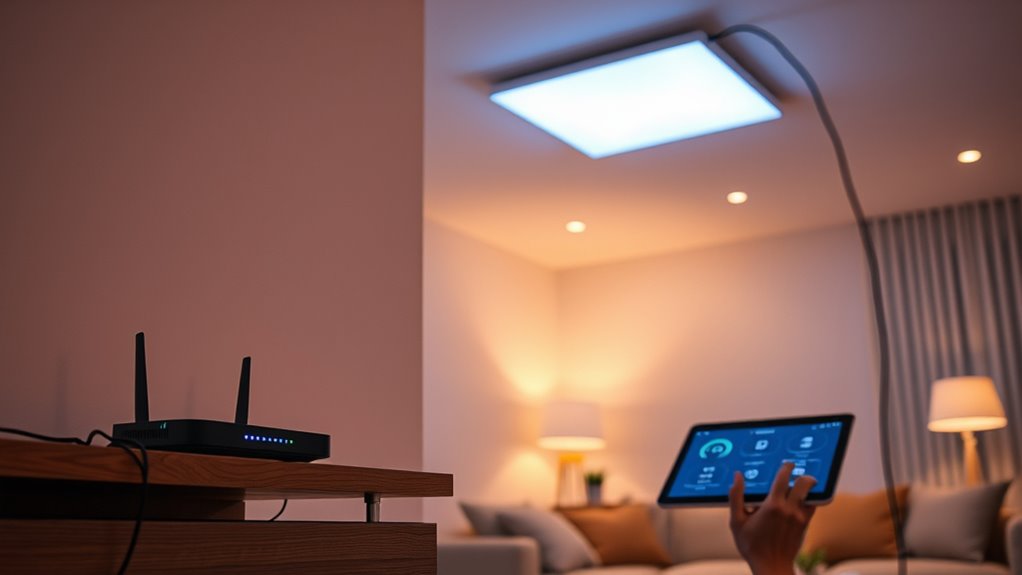
When comparing Wi-Fi and Li-Fi, understanding their cost considerations and infrastructure needs is essential. A thorough cost analysis reveals that Wi-Fi generally requires lower upfront expenses because it uses existing wireless routers and networks familiar to most homes. Li-Fi, on the other hand, involves significant infrastructure investment, including installing specialized LED lighting and optical transceivers. These components can be more costly initially, especially for widespread deployment. Additionally, Li-Fi’s infrastructure needs may require rewiring or replacing current lighting systems, increasing installation complexity. While Wi-Fi’s setup is straightforward and affordable, Li-Fi’s higher costs are offset by its potential for faster, more secure connections. Evaluating these factors helps you decide which technology aligns best with your budget and infrastructure readiness.
Future Potential and Developments
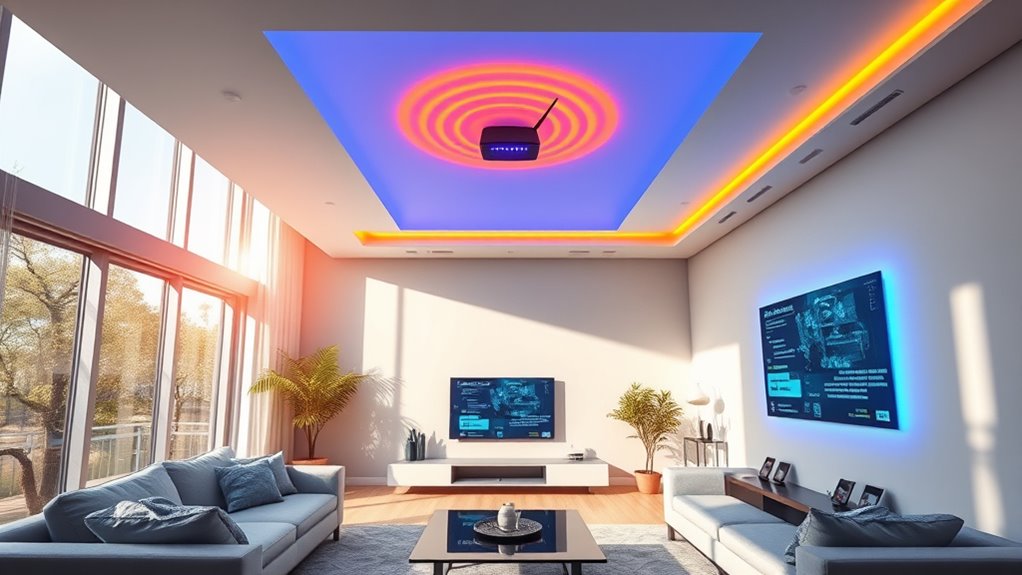
The future of Wi-Fi and Li-Fi technology holds promising advancements that could considerably impact how you connect to the digital world. Expect smarter homes with seamless smart home integration, where devices communicate effortlessly. Energy efficiency will also improve, reducing power consumption while maintaining high performance. Here are some exciting developments to look forward to:
- Enhanced speeds and bandwidth for smoother streaming and gaming
- Better security features, protecting your data with advanced encryption
- Integration with IoT devices, creating more connected and automated homes
- Innovations in energy-efficient hardware, lowering your household energy use
These advancements suggest a future where your home becomes more intelligent, efficient, and secure, whether using Wi-Fi or Li-Fi.
Which Technology Is Right for Your Home?
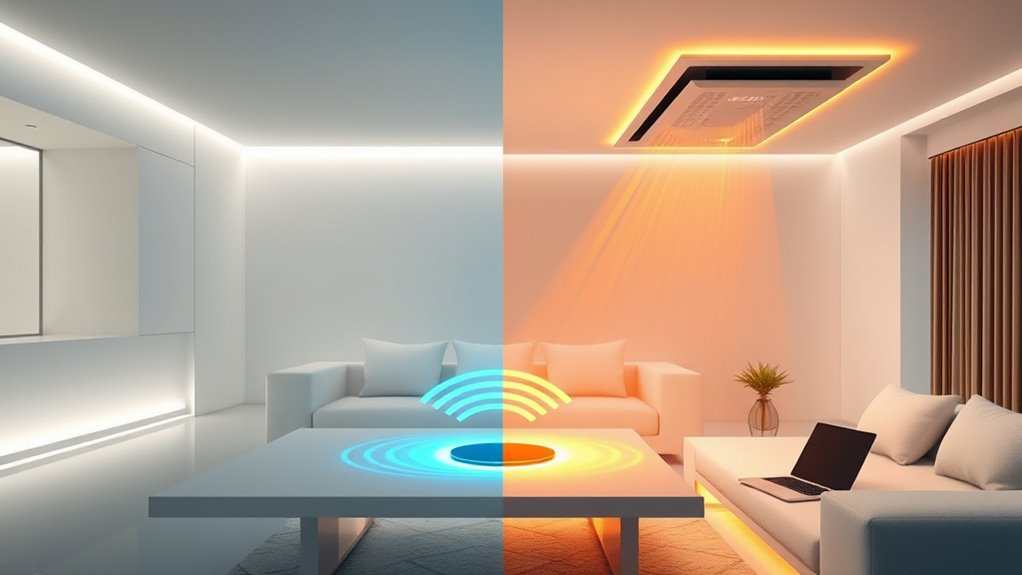
As smart home technology advances, choosing the right wireless connection becomes more important than ever. If your home relies on smart devices and wearable technology, consider your bandwidth needs and reliability. Wi-Fi is widely compatible, easy to set up, and handles multiple devices simultaneously, making it ideal for a busy smart home. It supports streaming, gaming, and high-bandwidth activities. Li-Fi, on the other hand, offers faster speeds and enhanced security but requires direct line-of-sight and LED lighting infrastructure. If your home prioritizes seamless connectivity for wearables and smart gadgets, Wi-Fi remains the practical choice. However, for future-proofing and specialized environments, exploring Li-Fi’s potential could be beneficial. Ultimately, assess your device ecosystem and internet demands to determine which technology suits your home best.
Frequently Asked Questions
How Do Wi-Fi and Li-Fi Impact Energy Consumption at Home?
You might wonder how Wi-Fi and Li-Fi impact your home’s energy consumption. Wi-Fi generally uses more power due to constant signal transmission, affecting energy efficiency. Li-Fi, on the other hand, consumes less power because it relies on visible light for data transfer, making it more energy-efficient. Choosing Li-Fi could reduce your home’s overall power consumption, helping you save on energy bills and contribute to a greener environment.
Can Li-Fi Be Used Outdoors or in Sunlight Conditions Effectively?
Think of Li-Fi as a whisper in a noisy room; sunlight can be that loud chatter. You might find outdoor interference and sunlight notably reduce Li-Fi’s effectiveness outside, making it less reliable in bright conditions. Sunlight’s intensity interferes with the light signals, so Li-Fi isn’t ideal for outdoor use when sunlight is strong. You’ll want to stick with traditional Wi-Fi outdoors for consistent, stable connectivity.
What Are the Environmental Benefits of Switching to Li-Fi?
Switching to Li-Fi offers notable environmental benefits. You’ll enjoy energy savings because Li-Fi uses LED lights that consume less power compared to traditional Wi-Fi routers. This reduces your overall energy use and helps lower your carbon footprint. Plus, since Li-Fi relies on visible light, it doesn’t emit electromagnetic interference, making it a greener, more sustainable choice for your home. You can contribute to a healthier planet with this innovative technology.
How Do Wi-Fi and Li-Fi Handle Multiple Device Connections?
When handling multiple device connections, Wi-Fi often faces device congestion and signal interference, especially in crowded environments, which can slow down your internet. Li-Fi, on the other hand, uses light for data transfer, reducing congestion and interference issues. You’ll find that Li-Fi can support many devices more efficiently, providing a more stable connection, while Wi-Fi might struggle with signal quality as more devices connect simultaneously.
Are There Compatibility Issues With Existing Home Devices for Li-Fi?
You might wonder if your existing home devices face compatibility issues with Li-Fi. Currently, Li-Fi relies on specialized hardware like LED lights and photodetectors, so most standard devices aren’t compatible without upgrades. Hardware limitations mean you need compatible equipment to connect. If your devices don’t support Li-Fi, you’ll need adapters or new hardware, making it less seamless than Wi-Fi for now.
Conclusion
Choosing between Wi-Fi and Li-Fi depends on your home’s needs and your tech goals. While Wi-Fi offers convenience and widespread compatibility, Li-Fi promises faster speeds and enhanced security. Remember, “The best time to plant a tree was 20 years ago; the second best time is now.” So, weigh your options, consider future developments, and pick the technology that will best serve your connected home’s needs today—and tomorrow.
